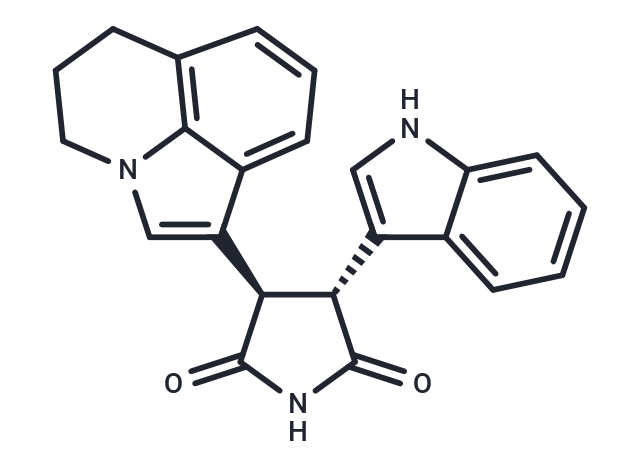Shopping Cart
- Remove All
 Your shopping cart is currently empty
Your shopping cart is currently empty

Tivantinib (ARQ 197) is an orally bioavailable small molecule inhibitor of c-Met with potential antineoplastic activity.

| Pack Size | Price | Availability | Quantity |
|---|---|---|---|
| 5 mg | $47 | In Stock | |
| 10 mg | $71 | In Stock | |
| 25 mg | $143 | In Stock | |
| 50 mg | $233 | In Stock | |
| 100 mg | $367 | In Stock | |
| 200 mg | $597 | In Stock | |
| 1 mL x 10 mM (in DMSO) | $54 | In Stock |
| Description | Tivantinib (ARQ 197) is an orally bioavailable small molecule inhibitor of c-Met with potential antineoplastic activity. |
| Targets&IC50 | c-Met:0.355 μM(Ki) |
| In vitro | Treatment with ARQ-197 across three heterotrophic transplantation models demonstrated a reduction in tumor growth: 66% in the HT29 model, 45% in the MKN-45 model, and 79% in the MDA-MB-231 model. Oral administration of 200 mg/kg ARQ-197 in these HT29, MKN-45, and MDA-MB-231 xenograft models did not result in significant weight changes. Pharmacologically, ARQ-197 notably inhibited the phosphorylation of c-Met in the human colon xenograft tumor HT29. A single oral dose of 200 mg/kg ARQ-197 led to a strong decrease in c-Met auto-phosphorylation after 24 hours. In summary, ARQ-197 inhibits the growth of c-Met-dependent human tumor xenografts. |
| In vivo | ARQ-197 exhibits antitumor activity by inhibiting the proliferation of A549, DBTRG, and NCI-H441 cells, with IC50 values of 0.38, 0.45, and 0.29 μM respectively. Treatment with ARQ-197 reduces phosphorylation in the MAPK signaling cascade, thereby preventing invasion and migration. Moreover, ectopic expression of c-Met in the NCI-H661 cell line, which lacks endogenous c-Met expression, leads to an invasive phenotype that is inhibited by ARQ-197. This compound also inhibits human recombinant c-Met with a constant Ki value of 355 nM and blocks downstream c-Met signaling pathways by inhibiting c-Met phosphorylation. Despite increased concentrations of ARQ-197 not significantly affecting the Km of ATP, exposure to 0.5 μM ARQ-197 results in a threefold decrease in the Vmax of c-Met. The decrease in Vmax without affecting ATP's Km suggests ARQ-197 inhibits c-Met through a non-ATP competitive mechanism, indicating high kinase selectivity. ARQ-197 suppresses both constitutive and ligand-mediated c-Met autophosphorylation, thereby inhibiting c-Met activity and downstream effectors. In human cancer cells expressing c-Met, including HT29, MKN-45, and MDA-MB-231, ARQ-197 induces an increase in caspase-dependent apoptosis. |
| Kinase Assay | c-Met SDS-PAGE in vitro kinase assay: Recombinant c-Met protein (100 ng) is preincubated with increasing concentrations of ARQ-197 for 30 minutes at room temperature. Following preincubation, 100 μM of poly-Glu-Tyr substrate and various concentrations of ATP containing 5 μCi of [γ-32P]ATP are added to the reaction mixture. The reaction is incubated for 5 minutes at room temperature and then stopped by the addition of 5 μL of SDS-polyacrylamide gel, reducing sample buffer. The samples are then loaded onto a 7.5% acrylamide gel and SDS-PAGE is performed. The phosphorylated poly-Glu-Tyr substrates are ultimately visualized by autoradiography. c-Met activity is quantified by densitometry. |
| Cell Research | HT29, MKN-45, and MDA-MB-231 cells are seeded in black 96-well plates at 5 × 103 cells per well overnight in a medium with 10% FBS. The next day, cells are treated with increasing concentrations of ARQ-197 (0.03-10 μM) for 24, 32, and 48 hours at 37 °C. After ARQ-197 treatment, the drug-containing medium is removed and cells are incubated for at least 10 minutes in a labeling solution (10 mM HEPES, 140 mM NaCl, and 6 mM CaCl2) containing 2 μg/mL Hoescht 33342 (blue channel), 500-times diluted Annexin V-FITC (green channel), and 1 μg/mL propidium iodide (red channel). High-content image acquisition and analysis are carried out. The program is set to take four images per well. The exposure time is set at 16.7 ms/10% gain, 500 ms/35% gain, and 300 ms/30% gain for the 4,6-diamidino-2-phenylindole, FITC, and rhodamine channels, respectively. Images are processed and the numbers of positive cells for each channel and each condition are determined. In addition, HT29 cells are treated with increasing concentrations of ARQ-197 for 32 hours in the absence or the presence of 25, 50, and 100 μM ZvAD-FMK (irreversible general caspase inhibitor), and the same procedures are undertaken. All experiments are done in triplicate. To determine whether the apoptotic effect is due to c-Met inhibition, the effect of ARQ-197 when glyceraldehyde-3-phosphate dehydrogenase (GAPDH) and c-Met are knocked down using siRNA is investigated. HT29, MKN-45, and MDA-MB-231 cells are transfected with a nontargeted control siRNA, a gapgh-targeted control siRNA, or a met-targeted siRNA. After 3 days, c-Met, GAPDH, and β-actin expression levels are determined using specific antibodies. To determine if the effect is caspase dependent, HT29, MKN-45, and MDA-MB-231 cells are transfected with a met-targeted siRNA for 2 days and incubated in the absence or the presence of increasing concentrations of ZvAD-FMK for 1 additional day.A nontargeted siRNA and a gapgh-targeted siRNA (siRNA GAPDH) are also transfected in parallel, as controls. Cells are then stained with Annexin V-FITC and propidium iodide, and the percentage of apoptotic cells is determined.(Only for Reference) |
| Alias | ARQ 197 |
| Molecular Weight | 369.42 |
| Formula | C23H19N3O2 |
| Cas No. | 905854-02-6 |
| Smiles | O=C1NC(=O)[C@H]([C@@H]1c1c[nH]c2ccccc12)c1cn2CCCc3cccc1c23 |
| Relative Density. | 1.49 g/cm3 |
| Storage | Powder: -20°C for 3 years | In solvent: -80°C for 1 year | Shipping with blue ice. | |||||||||||||||||||||||||||||||||||
| Solubility Information | DMSO: 68 mg/mL (184.07 mM), Sonication is recommended. Ethanol: < 1 mg/mL (insoluble or slightly soluble) H2O: < 1 mg/mL (insoluble or slightly soluble) | |||||||||||||||||||||||||||||||||||
Solution Preparation Table | ||||||||||||||||||||||||||||||||||||
DMSO
| ||||||||||||||||||||||||||||||||||||

Copyright © 2015-2025 TargetMol Chemicals Inc. All Rights Reserved.